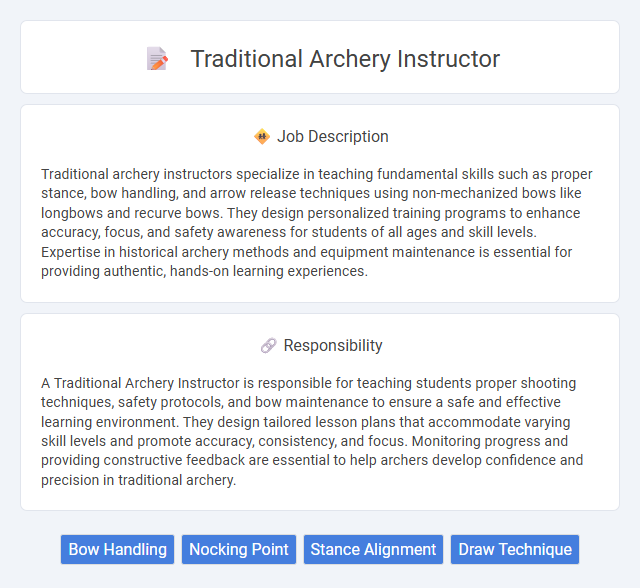
Traditional archery instructors specialize in teaching fundamental skills such as proper stance, bow handling, and arrow release techniques using non-mechanized bows like longbows and recurve bows. They design personalized training programs to enhance accuracy, focus, and safety awareness for students of all ages and skill levels. Expertise in historical archery methods and equipment maintenance is essential for providing authentic, hands-on learning experiences.
Individuals with a passion for history, patience, and strong communication skills are likely to find a role as a traditional archery instructor fulfilling. Physical fitness and good hand-eye coordination increase the probability of succeeding in this position. People who thrive in structured, outdoor environments and enjoy teaching others about ancient techniques may be well-suited for this occupation.
Qualification
A Traditional Archery Instructor requires extensive knowledge of archery techniques, including bow tuning, shooting form, and safety protocols. Certification from recognized bodies such as the Archery Trade Association or USA Archery enhances credibility and demonstrates proficiency in teaching various skill levels. Strong communication skills and experience in mentoring individuals in outdoor or sporting environments are essential for effectively guiding students.
Responsibility
A Traditional Archery Instructor is responsible for teaching students proper shooting techniques, safety protocols, and bow maintenance to ensure a safe and effective learning environment. They design tailored lesson plans that accommodate varying skill levels and promote accuracy, consistency, and focus. Monitoring progress and providing constructive feedback are essential to help archers develop confidence and precision in traditional archery.
Benefit
Traditional archery instructor jobs likely offer benefits such as improved physical fitness and enhanced focus due to consistent practice and teaching. There is a probable opportunity to develop strong communication skills and build a supportive community among students and fellow archery enthusiasts. These roles may also provide personal satisfaction from preserving cultural heritage and promoting outdoor recreational activities.
Challenge
A Traditional archery instructor likely encounters the challenge of teaching precise techniques without relying on modern equipment, which demands a deep understanding of historical methods and patient skill development. It is probable that they face the difficulty of tailoring lessons to varying student abilities while maintaining authenticity in traditional practices. Adapting instruction to ensure safety and engagement during hands-on learning may also present ongoing challenges in this role.
Career Advancement
Traditional archery instructors can advance their careers by obtaining certifications from recognized organizations such as the Archery Trade Association or USA Archery, which increase credibility and open doors to higher-level coaching roles. Developing expertise in specialized areas like historical archery techniques or bowyer skills enhances job prospects in museums, educational programs, and competitive archery clubs. Opportunities for career growth also include leading archery workshops, managing training programs, or transitioning into outdoor leadership and adventure sports education.
Key Terms
Bow Handling
Traditional archery instructors specialize in teaching precise bow handling techniques essential for consistent shooting accuracy. Mastery of grip, draw, anchor points, and release mechanics ensures safety and enhances performance with traditional longbows or recurve bows. These experts emphasize muscle memory development and stance alignment to improve overall shooting form and control.
Nocking Point
A traditional archery instructor specializes in teaching the fundamentals of traditional bow use, with a strong emphasis on the nocking point--a precise spot on the bowstring where the arrow is placed. Properly setting the nocking point ensures consistent arrow flight, optimal accuracy, and improved shot grouping, making it a critical element of archery training. Mastery of this skill enables instructors to guide students in achieving steady performance and safety in traditional archery techniques.
Stance Alignment
Traditional archery instructors emphasize precise stance alignment to enhance accuracy and consistency in shooting. Proper foot positioning, shoulder alignment, and balance are fundamental components taught to ensure stability and optimize draw strength. Mastery of stance alignment reduces shooting errors and improves overall performance in traditional archery.
Draw Technique
A Traditional Archery Instructor specializes in teaching proper draw techniques, emphasizing hand positioning, finger release, and consistent anchor points for accuracy. Mastery of the draw cycle, including the smooth pull, controlled hold, and steady aim, is critical for developing muscle memory and improving shot precision. Detailed guidance on body alignment and breath control enhances the archer's overall form and shot stability.
 kuljobs.com
kuljobs.com